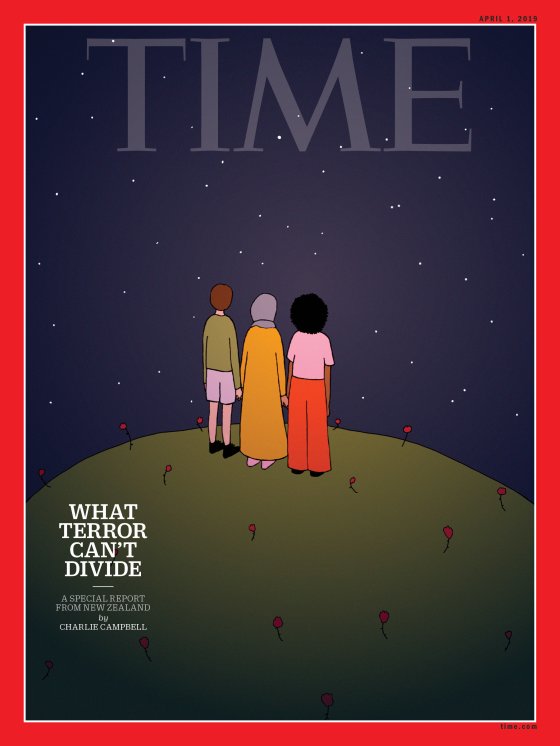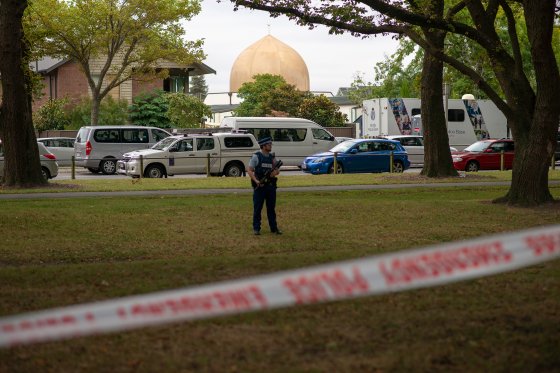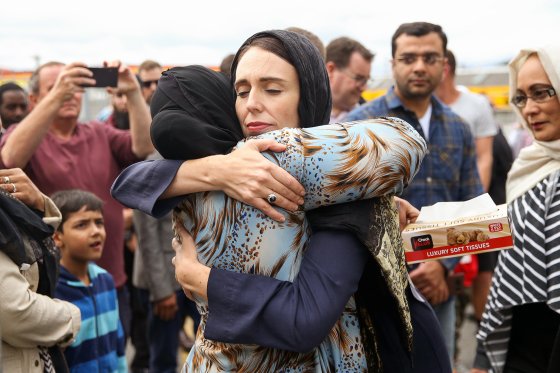
With an attack on a peaceful nation at the bottom of the world, white supremacists widen their violence
A few years back, some members of Christchurch’s Linwood mosque suggested installing security cameras outside. Anwar Alisaisy thought they were being ridiculous. Since immigrating to New Zealand from the Kurdish region of Iran in 2002, he’d seen no sign of trouble–not at the hairdresser’s where he worked nor at the mosque directly across the street where he prayed every Friday. “I said, ‘Nobody steals from the mosque. There’s no extremists,’” says Alisaisy. “New Zealand is the safest place.”
The father of six recalled this while standing at a length of police tape near the house of worship that is now a crime scene. He had been inside on March 15 when a white supremacist showed up with a carload of guns and a video camera on his helmet. “He was standing by the doorway shooting, and I fled to the back room,” says Alisaisy. “Children were crying, women yelling, and we could hear him keeping on shooting.”
The safety of a South Pacific island nation was not the only illusion destroyed that day. Also undone was the popular conception of international terrorism. The Christchurch attacks on two mosques that took at least 50 lives established white supremacy as a threat to Western societies nearly as formidable as terrorism carried out in the name of fundamentalist Islam–and one that, if anything, appears to draw even more oxygen from the Internet.
Long pigeonholed as “homegrown” or “domestic” terrorism, the violence of right-wing extremists emerged in remote New Zealand as a transnational threat. Here, a widely traveled and heavily armed Australian invoked white nationalism in the name of an international campaign against immigration. The magnitude of the attacks would have thrown the spotlight onto rightist extremism even if the killer had not streamed them on Facebook Live.

Jacinda Ardern, New Zealand’s Prime Minister, told TIME that governments around the world needed to “take a united front on what is a global issue,” especially in tackling the places on the Internet where radicalization takes root. In national-security circles, there were calls for governments to share intelligence on right-wing extremists “in ways previously reserved for groups like the Islamic State,” as three veteran U.S. counterterrorism officials wrote on the Lawfare blog.
Adding to the urgency are indications that right-wing extremists have been emboldened by political leaders expressing the same xenophobia and intolerance. “This attack has been brewing for some time,” says Clarke Jones, a terrorism expert at Australian National University. The attacker’s online expressions of rage against nonwhite, non-Christian immigrants, he says, were “being nearly endorsed by political rhetoric around banning immigration of Muslims and criminalizing refugees.”
The New Zealand attacks may offer a new window into how we think about terrorism. To Americans, the word has been synonymous with Sept. 11, 2001–shock attacks that came literally out of the blue and were carried out in the name of a faith that most Americans did not know firsthand.
But terrorism is not merely about belief. It’s about certainty. Convinced he was a soldier in a war visible only to an enlightened few, the alleged shooter, Brenton Tarrant, was as alarmed as any jihadi by the very things–tolerance, coexistence, inclusion–that drew Muslim worshippers to feel at home in a city named Christchurch. Although New Zealand was only 1% Muslim in the last census, its diversity offered what the shooter, in a self-styled “manifesto” he posted online and emailed to Ardern’s office just before the attack, called “as target-rich an environment as anywhere else.” The country was singled out, Ardern said, “because we represent diversity, kindness, compassion, a home for those who share our values.”
There are many parallels between far-right extremism and ISIS, “from the lost and angry young men targeted by it, to the propaganda, to the operations,” says Peter W. Singer, a strategist at the New America think tank and author of LikeWar: The Weaponization of Social Media. “Another tactic they both use is offering up a sense of fellowship. It’s a strange but very real combination of finding a community and finally feeling understood and appreciated, but they’re finding it through the expression of hate.”
The numbers bear out the concern, in the U.S. and elsewhere. In 2017, the FBI said it was conducting 1,000 investigations into white supremacists and other domestic terrorist threats, roughly as many as it had open into people who may have been inspired by the Islamic State, according to the Washington Post. From 2012 to 2017, the number of actual white-supremacist attacks more than doubled, from 14 to 31, according to the University of Maryland’s Global Terrorism Database. The Anti-Defamation League attributes 73% of extremist-related killings in the U.S. from 2009 to 2018 to the far right.

In Europe, where immigration from Muslim countries has exposed rifts in societies, the political surge to the right has been accompanied by supremacist violence. From 2016 to 2017, far-right attacks in Europe leapt by 43%. In 2016, just days before Britain’s divisive referendum on E.U. membership, the U.K. lawmaker Jo Cox was fatally shot and stabbed by a white supremacist who shouted, “Britain first.” Fear over how immigration was affecting British society played a major role in the U.K.’s Brexit decision, with 54% of “leave” voters calling Islam a threat to the British way of life. That belief helped feed the violence. “The right-wing threat was not previously organized,” the outgoing British counterterrorism chief, Mark Rowley, noted in February 2018. “Every now and then there’s been an individual motivated by that rhetoric who has committed a terrorist act, but we’ve not had an organized right-wing threat like we do now.”
That organizing often occurs online. Much has been made of the Internet savvy of jihadis, but right-wing extremists have been at home there since the dawn of the Internet. On Twitter, extremism researcher J.M. Berger found in a 2016 study, “American white-nationalist movements have seen their followers grow by more than 600% since 2012. Today, they outperform ISIS in nearly every social metric, from follower counts to tweets per day.”
But the true breeding ground for these extremists is on less-trafficked forums, like 8chan and 4chan, where anonymous users trade ostensibly ironic memes, jokes and discussions laced with racism and misogyny. It was on one of these where the alleged shooter announced his rampage and posted links to his written justification, as well as the Facebook live feed. Both quickly metastasized onto mainstream platforms–YouTube, Facebook and Twitter–despite the companies’ efforts to take them down. At one point, the video was being uploaded to YouTube at the rate of once a second, the Guardian reported.
Not all of the posts were admiring, and morbid fascination no doubt contributed. But the video that stayed in circulation had been altered to bypass the mainstream platforms’ filtering software. Far-right extremists have a proven talent for “exploiting the algorithms and the weaknesses of social-media platforms,” notes Julia Ebner, author of The Rage: The Vicious Circle of Islamist and Far-Right Extremism. “They’re able to distort public perception and have a disproportionately loud voice.”
That matters, Ebner notes, because in many Western countries, extremists can now count on the polite attention of politicians. “Over the last few years, across Europe especially, but in general across the world, we have seen a strong surge in the popularity of far-right populist parties, extremist ideologies and in-group vs. out-group thinking,” she says. “Their most common shared enemies are Muslims, migrants, the mainstream media and the ‘corrupt elite.’”
That kind of thinking was on prominent display in the aftermath of these attacks. Australian politician Fraser Anning suggested Muslim immigration was to blame. In Italy, hard-line Interior Minister Matteo Salvini condemned the “odious” killer but later played down the global threat of white supremacists. “The only extremism that merits attention is the Islamic kind,” he said.
President Donald Trump too suggested the white-nationalist threat was merely a “small group of people.” Trump may reject any association with the far right, but his policies have won him the support of a range of extremists; the shooter’s manifesto even named him as a symbol of the white supremacists’ fight. Indeed, on the day of the attacks, Trump spoke to a crowd defending his use of emergency powers to construct a border wall to keep migrants out. “People hate the word invasion but that’s what it is,” he said. The same word featured prominently in the killer’s screed.
The hard fact is that, in the U.S. at least, a measurable minority sympathize with the white-supremacist cause. A 2018 study from a University of Alabama researcher found that among white non-Hispanic Americans, 28% “expressed strong feelings of white identity; about 38% expressed strong feelings of white solidarity; and about 27% felt that whites suffer a meaningful amount of discrimination in American life.” In a recent Military Times poll, 22% of service members said they saw signs of white nationalism or racist ideology in the armed forces. About 35% called white nationalism a significant threat to the country. In February, a Coast Guard lieutenant was arrested with a cache of arms and a hit list of prominent Democrats. His indictment quoted a draft letter reading: “We need a white homeland as Europe seems lost.”
Most New Zealanders, like Americans, are descended from immigrants. The indigenous Maori people make up more than a sixth of the population, but they are joined by the descendants of British colonialists and more recent arrivals from the South Pacific, Europe, Asia and Africa. The diverse population is united by shared values of affability, self-deprecating humor and sports, particularly rugby and cricket. As in neighboring Australia, the standard salutation is “mate.” To pass someone in the street without offering a greeting would be considered an affront. “New Zealand is such an amazing country,” says Mazharuddin Syed Ahmed, 47, a university academic.
Ahmed was standing in Linwood mosque’s front row directly behind the imam on March 15. “I knew the sound was gunfire straight away,” he says. He took shelter in a small stall and saw the gunman shoot a screaming woman at close range and pull her down. “One of my close friends had his head blown right open in front of me,” he tells TIME with voice trembling. “It was horrific. Bullets were falling right next to me. I could smell gunpowder.” He tried to stem the bleeding of a severely wounded friend. “He couldn’t tell me where he was shot but just kept saying, ‘Please call the doctor! Please call the doctor!’” It took two surgeries but that friend survived.
Many did not. Among the 50 killed in the attack were several children. New Zealand has only 4.8 million people, and proportionally, the loss was larger than 9/11 was for the U.S. “It is certainly now obviously a part of our history,” Ardern told TIME. “It is our darkest of days, there is no question.”

Under the 38-year-old Prime Minister, New Zealand will boost its annual refugee quota from 1,000 to 1,500 beginning next year. She has called it “the right thing to do.” Yet despite New Zealand’s culture of ethnic harmony, it also felt to some like things were slipping. Stories about minorities in the mainstream media immediately attract hate-filled comments online. Over the past five years, the Islamic Women’s Council complained to government agencies of rising vitriol and hatred targeting the Muslim community, but says nothing was done. According to Jones, New Zealand has 70 far-right groups.
Former soldier Pete Breidahl said he was shocked to see Confederate flags at Dunedin’s Bruce Rifle Club, where the accused shooter was a member, when he visited there in 2017. Breidahl says people there donned camouflage gear and complained that an influx of refugees would lead to a terrorist attack. They were “clearly basement-dwelling nerds living out homicidal fantasies,” he tells TIME. “Why would you want to shoot guns dressed like one of the Columbine massacre shooters?” (The gun club, which reported that it has now closed for the “foreseeable future,” denies that members harbor extremist views.)
New Zealand has about 250,000 licensed gun owners and an estimated 1.2 million registered firearms. But it took just a day for Ardern to say the nation’s gun laws “will change.” By March 18, her Cabinet had agreed in principle to amendments to “make our community safer,” Ardern said. Trade Me, New Zealand’s most popular auction site, announced it was voluntarily banning the sale of semiautomatic weapons. TIME saw shaken teenagers approaching police officers on the street to ask how best they could hand in their parents’ firearms. The killer acquired his weapons legally via an ordinary gun license he obtained in 2017 and kept despite a brazenly xenophobic social-media presence.
In acting quickly to contain public outrage, Ardern followed a course that had worked elsewhere. Australia restricted access to military-style weapons following the Port Arthur massacre of 1996, in which 35 people were killed. The U.K. banned private ownership of handguns in 1997 following the Dunblane massacre, when a gunman murdered 16 schoolchildren and a teacher before killing himself. Both nations have seen gun-related deaths plummet.
New Zealand has also taken the decision not to give the shooter the soapbox he so clearly craves. Ardern has refused to utter his name, and reporting restrictions mean his picture has been banned from newspapers. Instead, New Zealanders have chosen to focus on unity. Christians, Hindus, Jews, Buddhists and Sikhs offered food and support for survivors and victims’ families. At flower memorials, hipsters with dyed blue hair comforted women in hijabs. Christchurch Mayor Lianne Dalziel tells TIME that the Islamic greeting As-salaamu ‘alaikum, or “Peace be with you,” is “very much an expression of the peaceful city that we were and still are.”
Muslim communities around the world are watching how New Zealand responds with sympathy and also with gratitude. “When you have a leader like Jacinda Ardern coming out and defending people under attack, that sends a strong message,” said Harun Khan, secretary general of the Muslim Council of Britain. “It’s demonstrated the complete opposite of what the terrorist wanted to achieve.”
On March 20, the city began laying the dead to rest, bodies facing toward Mecca. Both the al-Noor and Linwood mosques remained off-limits, still strung with police tape. When they reopen, it will surely be with security cameras and other precautions now deemed essential. But some survivors say they won’t return. “I chose this country because it’s safe for my kids and family,” says Mohsan Ali, 37, who survived the al-Noor massacre with his pregnant wife. “But now I think we’re not safe.”
For Ahmed, it’s chilling enough that Christchurch schoolchildren locked down in their classrooms could watch the slaughter unfold in real time on their smartphones. More terrifying was the flurry of cheers and gleeful comments online racists attached to the murderous scenes. “We underestimate the power of hatred,” Ahmed says.
–With reporting by ABIGAIL ABRAMS and KARL VICK/NEW YORK; SUYIN HAYNES, JOSEPH HINCKS, CIARA NUGENT, BILLY PERRIGO and MADELINE ROACHE/LONDON; and ELIZABETH THOMSON, HARRY POLAND and CONNOR STIRLING/CHRISTCHURCH
